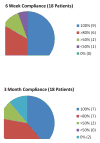Outcomes of rigid night splinting and activity modification in the treatment of cubital tunnel syndrome
- PMID: 23647638
- PMCID: PMC3989882
- DOI: 10.1016/j.jhsa.2013.02.039
Outcomes of rigid night splinting and activity modification in the treatment of cubital tunnel syndrome
Abstract
Purpose: To prospectively analyze, using validated outcome measures, symptom improvement in patients with mild to moderate cubital tunnel syndrome treated with rigid night splinting and activity modifications.
Methods: Nineteen patients (25 extremities) were enrolled prospectively between August 2009 and January 2011 following a diagnosis of idiopathic cubital tunnel syndrome. Patients were treated with activity modifications as well as a 3-month course of rigid night splinting maintaining 45° of elbow flexion. Treatment failure was defined as progression to operative management. Outcome measures included patient-reported splinting compliance as well as the Quick Disabilities of the Arm, Shoulder, and Hand questionnaire and the Short Form-12. Follow-up included a standardized physical examination. Subgroup analysis included an examination of the association between splinting success and ulnar nerve hypermobility.
Results: Twenty-four of 25 extremities were available at mean follow-up of 2 years (range, 15-32 mo). Twenty-one of 24 (88%) extremities were successfully treated without surgery. We observed a high compliance rate with the splinting protocol during the 3-month treatment period. Quick Disabilities of the Arm, Shoulder, and Hand scores improved significantly from 29 to 11, Short Form-12 physical component summary score improved significantly from 45 to 54, and Short Form-12 mental component summary score improved significantly from 54 to 62. Average grip strength increased significantly from 32 kg to 35 kg, and ulnar nerve provocative testing resolved in 82% of patients available for follow-up examination.
Conclusions: Rigid night splinting when combined with activity modification appears to be a successful, well-tolerated, and durable treatment modality in the management of cubital tunnel syndrome. We recommend that patients presenting with mild to moderate symptoms consider initial treatment with activity modification and rigid night splinting for 3 months based on a high likelihood of avoiding surgical intervention.
Type of study/level of evidence: Therapeutic II.
Copyright © 2013 American Society for Surgery of the Hand. Published by Elsevier Inc. All rights reserved.
Figures
Similar articles
-
Surgical and nonsurgical treatment of cubital tunnel syndrome in pediatric and adolescent patients.J Hand Surg Am. 2012 Apr;37(4):657-62. doi: 10.1016/j.jhsa.2012.01.016. Epub 2012 Mar 2. J Hand Surg Am. 2012. PMID: 22386551
-
Validity and responsiveness of the DASH questionnaire as an outcome measure following ulnar nerve transposition for cubital tunnel syndrome.Plast Reconstr Surg. 2013 Jul;132(1):81e-90e. doi: 10.1097/PRS.0b013e318290faf6. Plast Reconstr Surg. 2013. PMID: 23806957
-
Outcomes following modified oblique medial epicondylectomy for treatment of cubital tunnel syndrome.J Hand Surg Am. 2013 Feb;38(2):336-43. doi: 10.1016/j.jhsa.2012.11.006. Epub 2013 Jan 3. J Hand Surg Am. 2013. PMID: 23291082
-
Cubital tunnel syndrome - a review and management guidelines.Cent Eur Neurosurg. 2011 May;72(2):90-8. doi: 10.1055/s-0031-1271800. Epub 2011 May 4. Cent Eur Neurosurg. 2011. PMID: 21547883 Review.
-
[Cubital tunnel syndrome : Diagnostics and therapy].Orthopade. 2017 Aug;46(8):717-726. doi: 10.1007/s00132-017-3453-z. Orthopade. 2017. PMID: 28741034 Review. German.
Cited by
-
Conservative treatment of cubital tunnel syndrome: A systematic review.Orthop Rev (Pavia). 2019 Jun 12;11(2):7955. doi: 10.4081/or.2019.7955. eCollection 2019 May 23. Orthop Rev (Pavia). 2019. PMID: 31281598 Free PMC article.
-
The Use of Physiotherapy in the Conservative Treatment of Cubital Tunnel Syndrome: A Critical Review of the Literature.Diagnostics (Basel). 2024 Jun 6;14(11):1201. doi: 10.3390/diagnostics14111201. Diagnostics (Basel). 2024. PMID: 38893728 Free PMC article. Review.
-
Differential expression of miRNAs in Osborne's ligament of cubital tunnel syndrome.Mol Med Rep. 2017 Jul;16(1):687-695. doi: 10.3892/mmr.2017.6663. Epub 2017 May 31. Mol Med Rep. 2017. PMID: 28586055 Free PMC article.
-
Evaluation of Sleep Position for Possible Nightly Aggravation and Delay of Healing in Tennis Elbow.J Am Acad Orthop Surg Glob Res Rev. 2019 Aug 2;3(8):e082. doi: 10.5435/JAAOSGlobal-D-19-00082. eCollection 2019 Aug. J Am Acad Orthop Surg Glob Res Rev. 2019. PMID: 31592507 Free PMC article.
-
Conservative therapy in ulnar neuropathy at the elbow (Review).Exp Ther Med. 2022 Jun 15;24(2):517. doi: 10.3892/etm.2022.11444. eCollection 2022 Aug. Exp Ther Med. 2022. PMID: 35837045 Free PMC article. Review.
References
-
- Dellon AL. Review of treatment results for ulnar nerve entrapment at the elbow. J Hand Surg Am. 1989;14(4):688–700. - PubMed
-
- Bozentka DJ. Cubital tunnel syndrome pathophysiology. Clin Orthop Relat Res. 1998;(351):90–94. - PubMed
-
- Britz GW, Haynor DR, Kuntz C, et al. Ulnar nerve entrapment at the elbow: correlation of magnetic resonance imaging, clinical, electrodiagnostic, and intraoperative findings. Neurosurgery. 1996;38(3):458–465. discussion 465. - PubMed
-
- Novak CB, Lee GW, Mackinnon SE, Lay L. Provocative testing for cubital tunnel syndrome. J Hand Surg Am. 1994;19(5):817–820. - PubMed
MeSH terms
Grants and funding
LinkOut - more resources
Full Text Sources
Other Literature Sources
Research Materials



